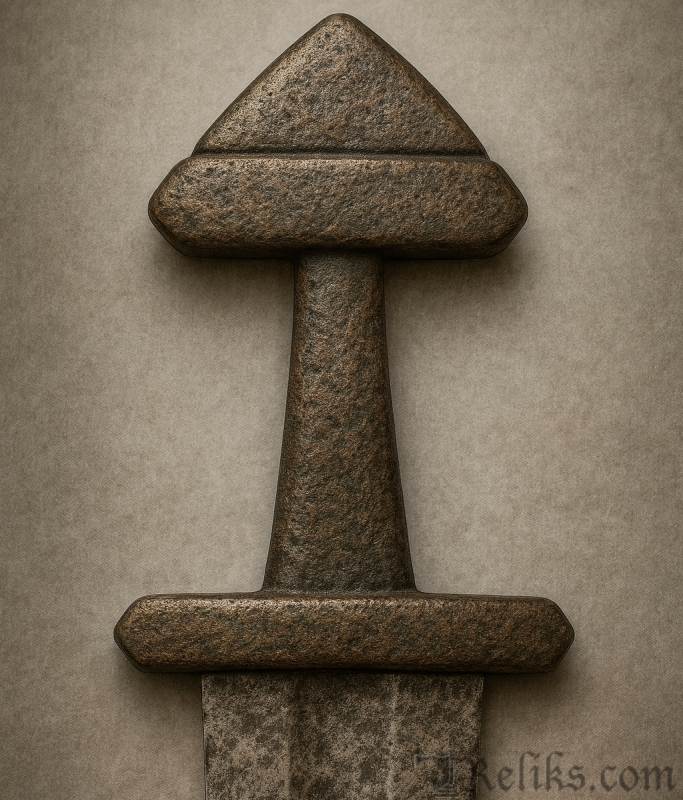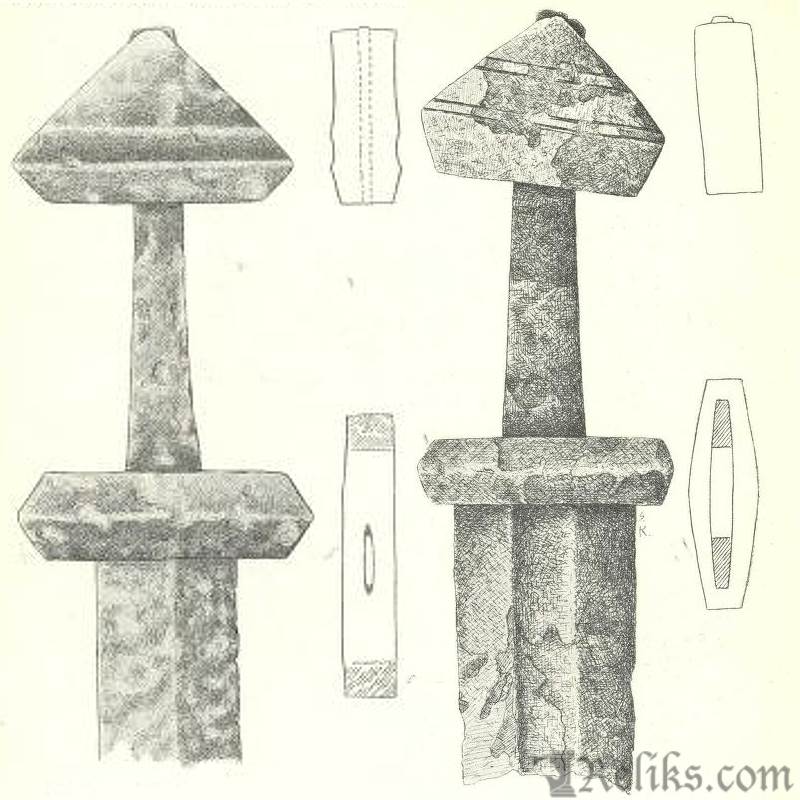Viking Sword Type C – The Heavyweights of Early Viking Age
From Transitional to Viking Proper
If Type A and Type B represent the last echoes of the Iron Age, Type C marks the true beginning of the Viking sword. These weapons are massive, solid, and unmistakably built for the battlefield. With guards that could tower over six centimeters tall and weights approaching two kilograms, they stand among the heaviest swords of the Viking Age.
Archaeological Description

Viking Sword Type C – The Heavyweights of Early Viking Age
Type C is a direct development of Type B. The pommel (upper guard) is solid, five-sided, and usually of uniform thickness, though occasionally tapering slightly. Its broad faces are often decorated with horizontal ridges or raised edges — one marking the division between guard and pommel, and another framing the outer corners.
Some specimens even imitate delicate metalwork: one example from the Sandvig collections shows a ridge resembling beaded wire, while another (B 1622 from Vik, Sogn) still contains traces of actual wire once inlaid into grooves. Other variants display incised stripes or raised bands, suggesting imitation of twisted or smooth wire inlay. A few smaller hilts are completely plain, without decoration.
The lower guard often matches this style, with ridges and concave shaping, and sometimes shares the same imitation wire designs. All hilts of this type are massive and solid, giving the sword a strikingly heavy impression.
The pommel could reach heights of up to 6.4 cm, and Petersen measured one sword from Vik, Nes, Hallingdal at 1.896 kg — the heaviest sword he weighed in his studies. Only Type D might rival it in weight.
Among the recorded specimens, 67 are single-edged and 40 are double-edged, with three lacking blades. None are pattern-welded, though one sword bears a rare rune inscription on the blade rather than the more typical Latin letters.
Relationships to Other Types

Petersen Sketches (fig.57-58)
Type C clearly develops out of Type B, but it is heavier, broader, and more imposing. It also paved the way for Type D and beyond, with which it often co-occurs in grave finds. Its prevalence of single-edged blades suggests a link to the older, guardless single-edged swords of the 7th period — a “homegrown” Scandinavian continuation.
Interestingly, Petersen noted cases where C-type upper guards were paired with H-type lower guards, showing that smiths were experimenting and mixing features during this period.
Historical & Cultural Context
Type C belongs firmly to the earliest Viking Age, beginning at the transition from the late 8th century and continuing through the first half of the 9th century. This was the age when Scandinavia erupted into history through raids on Lindisfarne (793), Francia, and beyond.
The massive weight of Type C swords reflects a warrior culture in flux: these were prestige weapons, built not only for cutting but for commanding respect. Many examples are single-edged — unusual by later standards, but consistent with the Scandinavian habit of adapting earlier forms.
The rune inscription on one sword also shows the growing role of written symbols in warrior culture, tying weaponry to identity and belief.
Distribution and Finds
Type C is widely distributed across Norway — from the inner districts of Kristians and Buskerud, to Bratsberg, to western regions from Jæren up to Trøndelag. Curiously, it is scarce in Hedmark and Akershus, despite their richness in other Viking finds.
Beyond Norway, Petersen recorded examples from Sweden (Uppland, Gotland, Värmland, Kalmar), Finland, the Orkneys, and even collections in Britain and Ireland. These finds confirm that Type C was not only a Norwegian form but part of the broader Scandinavian weapon tradition.
Associated grave goods include:
- Axes (mostly Type D, with some B and E)
- Spearheads (Types E, B, and F)
- Shield bosses of type R 564
- Older rattle amulets and oval brooches
These combinations strongly support dating to the early Viking Age, especially the first half of the 9th century.
For Collectors and Enthusiasts
Type C swords fascinate collectors because of their sheer size and weight. While not ornate, they represent the Viking sword at its most imposing. Their rarity outside of museums makes them a prized design for historians and reenactors, though replicas are scarce due to their mass and complexity.
For enthusiasts, they embody the moment when Viking swords became uniquely Scandinavian — massive, functional, and culturally distinct from continental influences.
Closing Reflection
Type C is the first sword type that feels truly “Viking.” It combines native Scandinavian traditions with refinements borrowed from older Iron Age weapons, producing a heavy, no-nonsense sword for a warrior society about to explode onto the European stage. From Type C onward, Viking swords were no longer transitional — they were definitive.
Core classification based on Jan Petersen, De Norske Vikingesverd (1919). Additional commentary by Reliks.com.